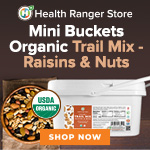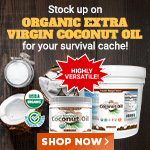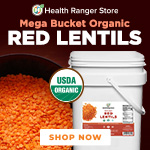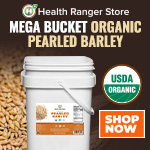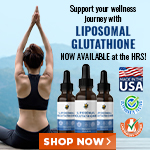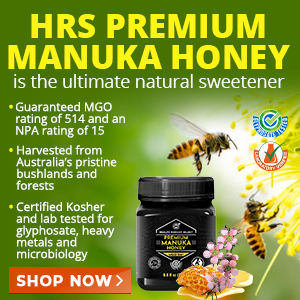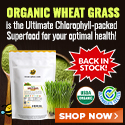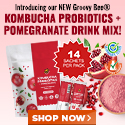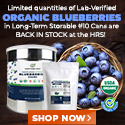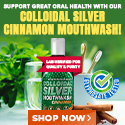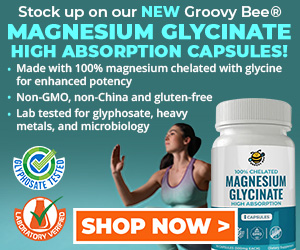Cadmium is a disease-related avoidable pollutant with manmade causes
Thursday, July 17, 2014 by: Cody L
Tags: cadmium, heavy metal, industrial pollutant

- Newly released JFK files reveal Pentagon's role in creating Lyme disease and covid in the same lab
- The hidden dangers in your kitchen: How cooking methods impact diabetes, cancer and aging
- DEADLY DECEPTION: How COVID vaccines increased mortality rates and why authorities hid the truth
- CDC finally halts $11 billion COVID funding scam as health officials admit the ‘pandemic’ was a fraud
- Arkansas embraces medical freedom with landmark ivermectin law
- GAIN-OF-FUNCTION CAT-BIRD-FLU now on the rise as nearly a dozen cats in Colorado "test positive" for Bird Flu due to contaminated cat food
- Lab leak confirmed? Boris Johnson's stunning reversal on COVID origins sparks global debate
- Home gardening for preppers: A beginner's guide to growing your own food
- Trump's greatest betrayal so far: Accelerating Middle East wars, silencing dissent, and serving Zionist masters
- Cartels shift tactics: Kidnappings and organ trafficking surge as border crossings plummet under Trump policies
- Why you should think twice before buying mainstream toothpaste formulas
- Was JFK's assassination orchestrated by a CIA double agent? New evidence points to James Angleton as the “architect”
- ATTENTION PRESIDENT TRUMP: Please WITHDRAW your nomination of Dr. Susan Monarez for CDC Director as she is a VAX FANATIC and TOXIC JAB ZEALOT
- Key nodes of Federal Government censorship
- Record honeybee deaths devastate U.S. agriculture, pesticides under scrutiny
- Speaker Johnson warns Congress may defund or disband rogue courts targeting Trump
- Paper or plastic? The environmental deception behind bag bans
- Here are TEN all-natural ways to protect your garden without using harmful chemicals
- Newly released JFK files reveal Pentagon's role in creating Lyme disease and covid in the same lab
- Elon Musk: Aliens could be here on Earth RIGHT NOW
- Festive flavors: The sweet history, nutritional profile and health benefits of pecan pie
- Trump reverses course on Gaza plan, says “nobody is expelling Palestinians”
- Reclaim your health: How midlife exercise reverses years of inactivity
- Big Pharma's $8 Billion bribery scheme exposed: how doctors are pushed to prescribe junk science, not heal
- Boys are back in town: Trump’s patriotic alpha crew takes the wheel while toxic females ride in the backseat
- EPA advisor admits the agency is funneling billions to climate groups ahead of Trump’s return to White House
- Space war brewing? Russia threatens to destroy Starlink satellites
- Survival 101: Effective EMF blocking techniques
- A lack of integrity in Academia: Harvard professor found GUILTY of fraudulent research to promote CRT theory
- Mike Adams Sermon 66: God will DESTROY ISRAEL for its wickedness
- 5 Simple steps to boost your brainpower: How to strengthen executive function in a distracted world
- Rep. Nancy Mace introduces bill to ban biological males from female facilities on federal property
- Sugarcane extract superior to cholesterol-lowering drugs?
- WHO focusing more on policing speech about public health and implementing global surveillance systems
- Pilots report mysterious lights 'moving at extreme speeds' across Oregon skies
- Dr. Mike Yeadon releases 15-minute testimony - WATCH - about genocidal intent of COVID “vaccines”
- EPA advisor admits the agency is funneling billions to climate groups ahead of Trump’s return to White House
- The Health Ranger releases “Vaccine Zombie” song and music video, using AI-animated zombies for the music video
- California's social media censorship law struck down: A victory for free speech or a threat to online safety?
- Dr. Mike Yeadon releases 15-minute testimony - WATCH - about genocidal intent of COVID “vaccines”
- The pandemic as a tool for INDOCTRINATION: Understanding “The Indoctrinated Brain” by Dr. Michael Nehls
- Florida takes a stand: DeSantis proposes permanent ban on mRNA vaccine mandates
- Mike Adams releases country western hit single: Goin’ Back in Time is Comin’ Home
- Mike Adams releases music poetry sensation: A Child of God
- “Why we influenced the 2020 elections”: Facebook files reveal the coordinated effort to bury the Hunter Biden laptop story
- RFK Jr. clears key hurdle: Sen. Susan Collins backs controversial HHS nominee, signaling a new era for health policy
- Unpacking the Lies That We’ve Been Fed – new song and music video released by Mike Adams, the Health Ranger
- Mike Adams releases new song and music video: Nothing More Disgusting Than a Globalist
- Newly released JFK files reveal Pentagon's role in creating Lyme disease and covid in the same lab
- Congratulations to the FULLY UNVACCINATED as you resisted the COVID-19 PROPAGANDA MACHINE fueled by over $100 BILLION
- Michigan sheriff announces criminal investigation into 2020 election crimes, Dominion Voting Systems
- Israeli soldiers accused of even more torture and abuse in the West Bank
- Migrants are taking advantage of recent hurricanes to scam residents and loot their homes
- House Intelligence Committee calls for the ARREST and PROSECUTION of Dr. Anthony Fauci
- Red Cross issues warning to stop blood plasma donations from vaccinated people
- Scientists confirm: GENIUS brain function can be spontaneously unleashed in humans without any apparent cause
- EPA advisor admits the agency is funneling billions to climate groups ahead of Trump’s return to White House
- HYSSOP: What research reveals about the health benefits of this ancient holy herb
- Two containers with completed ballots fall out of truck in Florida
- Fully vaccinated about to see “tsunami” of illness and death, warns virologist
- Global leaders unite to clamp down on “misinformation” with UN-backed Cascais Declaration
- BREAKING: 2025 NDAA authorizes mandatory military draft of WOMEN across America… as Pentagon pursues global NUCLEAR war with both Russia and China at the same time
- Michael Yon warns of a ZIONIST TAKEOVER in Trump’s second administration
- BOMBSHELL: DNA testing kits are a SCAM to develop ethnic-specific bioweapons
- Ozempic and Wegovy weight loss drugs are injectable LIZARD VENOM PEPTIDES that may unleash a devastating wave of organ failure… side effects align with symptoms of SNAKE BITES
- Israeli soldiers accused of even more torture and abuse in the West Bank
- These 13 countries just signed an agreement to engineer a global FAMINE by destroying food supply
- NASA admits that climate change occurs because of changes in Earth’s solar orbit, and NOT because of SUVs and fossil fuels
- RFK Jr. clears key hurdle: Sen. Susan Collins backs controversial HHS nominee, signaling a new era for health policy
- Sermon 30: How Jesus reveals Caesar’s FAKE CURRENCY and FALSE AUTHORITY
- Coriander seeds: Ancient medicine backed by modern science
- Arizona officials claim Maricopa County needs 10-13 days to tabulate results of the election
Most cadmium in the US comes from Florida's phosphate fertilizer industry, which produces 80% of phosphate rock in the country and is the largest phosphate rock mine in the world due to recoverable product. Wyoming, Idaho, and Utah form the 'Western Phosphate Field', and Morocco, South Africa, and Mexico contain the rest of the major reserves in the world and signify potential heavy metal pollution hotspots. However, 200 of the world's 265 million metric tons of recoverable phosphate come from the US, which has vulnerable agriculture. Purchasing organic foods which avoid these fertilizers helps to reduce cadmium intake by an estimated 48%. Herbal teas protect the cells and lower cadmium accumulation in organs, including the brain from it's contribution to Alzheimer's disease.
Natural substances to protect organs from cadmium
Blood: Licorice extract protects lymphocytes from cadmium, African roselle hibiscus protects against macrophage activation, Onion extract controls altered proteins and fats in blood from cadmiumTestes: Date palm pollen, Guarana, Tribulus and Onion extracts protect spermatogenesis from cadmium, Ginkgo biloba, Fenugreek seed power extract, Inca berry fruit extract, Holy basil extract
Kidneys: Propolis and Tribulus extract protects kidney cells from cadmium induced ROS, Greater Celandine alcohol extract normalizes all parameters, Chinese Eucommia ulmoides bark extract, Oregano extract, Onion extract, Tunisian radish (Raphanus sativus) extract, Grape seed procyanidin extract
Liver: Tribulus and Tomato extracts, Piper betle leaf extract, Oregano extract, Eleuthero Root extract, Fenugreek seed powder extract, Onion extract, Greater burdock extract, Blueberry pigment extract, Korean red ginseng extract
Brain: Quercetin protects memory and against anxiety from cadmium, Soy isoflavone Genistein
Heart: Onion extract protects heart by controlling blood against cadmium, water extract of Curry leaf (Murraya koenigii) restores all damaged parameters.
Thymus: Tunisian radish (Raphanus sativus) extract
Spleen: Tunisian radish (Raphanus sativus) extract
Pancreas: Ginger root extract, Nigella sativa black seed extract
Conclusion:
Commercial grain crops like cereal will continue to be a large source of dietary cadmium as long as major farm corporations continue to use these harmful fertilizers containing up to 300 milligrams per kilogram of cadmium. Each milligram may spread into the air and rain down in nearby crops, and tobacco crops show extensive heavy metal radioactivity from these actions. Calcium levels increase in the urine with more exposure, and cadmium's halflife is 20 years, with a person consuming 500 micrograms a week or 2,000 milligrams a lifetime. People are also exposed from industrial production and processing of batteries. These factories which cause small communities to have terrible health all around the world are linked to many heavy metals in just this same way.Sources:
http://www.ncbi.nlm.nih.gov/pubmed/23325115
http://www.ncbi.nlm.nih.gov/pubmed/22998418
http://www.ncbi.nlm.nih.gov/pubmed/22870013
http://www.ncbi.nlm.nih.gov/pubmed/22791161
http://www.ncbi.nlm.nih.gov/pubmed/22670477
http://www.ncbi.nlm.nih.gov/pubmed/22659242
http://www.ncbi.nlm.nih.gov/pubmed/22507840
http://www.ncbi.nlm.nih.gov/pubmed/22484604
http://www.ncbi.nlm.nih.gov/pubmed/23961183
http://www.ncbi.nlm.nih.gov/pubmed/22182640
http://www.ncbi.nlm.nih.gov/pubmed/22181069
http://www.ncbi.nlm.nih.gov/pubmed/22022002
http://www.ncbi.nlm.nih.gov/pubmed/21858388
http://www.ncbi.nlm.nih.gov/pubmed/20428964
http://www.ncbi.nlm.nih.gov/pubmed/19723071
http://www.ncbi.nlm.nih.gov/pubmed/24952260
http://www.ncbi.nlm.nih.gov/pubmed/24813645
http://www.ncbi.nlm.nih.gov/pubmed/23727273
http://www.ncbi.nlm.nih.gov/pubmed/22342528
http://www.ncbi.nlm.nih.gov/pubmed/24929543
http://www.ncbi.nlm.nih.gov/pubmed/24751684
http://www.ncbi.nlm.nih.gov/pubmed/24736979
http://www.ncbi.nlm.nih.gov/pubmed/24728876
http://www.ncbi.nlm.nih.gov/pubmed/24524755
http://www.ncbi.nlm.nih.gov/pubmed/23958968
http://www.ncbi.nlm.nih.gov/pubmed/24918346
http://www.ncbi.nlm.nih.gov/pubmed/23869259
http://www.ncbi.nlm.nih.gov/pubmed/23717155
http://www.ncbi.nlm.nih.gov/pmc/articles/PMC3984227/
http://www.ncbi.nlm.nih.gov/pubmed/24968103
http://www.atsdr.cdc.gov/toxprofiles/tp5-c6.pdf
http://pedology.ac.affrc.go.jp/specialI/SI54_3/sepPDF/01_Grant.pdf
http://www.epa.gov/radiation/tenorm/fertilizer.html
http://www.ncbi.nlm.nih.gov/pmc/articles/PMC4030994/
http://www.ncbi.nlm.nih.gov/pmc/articles/PMC3753751/
http://www.ncbi.nlm.nih.gov/pubmed/17920001/
http://www.ncbi.nlm.nih.gov/pmc/articles/PMC3460286/
http://www.ncbi.nlm.nih.gov/pubmed/11665459/
http://www.ncbi.nlm.nih.gov/pmc/articles/PMC1247384/
http://www.ncbi.nlm.nih.gov/pubmed/10854441/
http://www.ncbi.nlm.nih.gov/pubmed/16757843
http://www.iasj.net/iasj?func=fulltext&aId=76185
http://pdf.usaid.gov/pdf_docs/PNADW835.pdf
http://research.ncl.ac.uk
About the author:
Cody Lakeland is a freelance writer in fields such as nutrition, phytomedicine, neurology, gerontology, epigenetics, and toxicology. He currently helps to coordinate the formulas for a internet/home-based community business specializing in customized alternative therapies.
Cadmium at FETCH.news
Get independent news alerts on natural cures, food lab tests, cannabis medicine, science, robotics, drones, privacy and more.
Take Action: Support Natural News by linking to this article from your website
Permalink to this article:
Embed article link: (copy HTML code below):
Reprinting this article:
Non-commercial use OK, cite NaturalNews.com with clickable link.
Follow Natural News on Facebook, Twitter, Google Plus, and Pinterest
Science News & Studies
Medicine News and Information
Food News & Studies
Health News & Studies
Herbs News & Information
Pollution News & Studies
Cancer News & Studies
Climate News & Studies
Survival News & Information
Gear News & Information
News covering technology, stocks, hackers, and more



"Big Tech and mainstream media are constantly trying to silence the independent voices that dare to bring you the truth about toxic food ingredients, dangerous medications and the failed, fraudulent science of the profit-driven medical establishment.
Email is one of the best ways to make sure you stay informed, without the censorship of the tech giants (Google, Apple, Facebook, Twitter, YouTube, etc.). Stay informed and you'll even likely learn information that may help save your own life."
–The Health Ranger, Mike Adams














